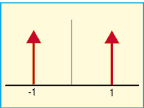INDICATORS
One Fish, Two Fish
Using The Fisher Transform
by John F. Ehlers
Looking for better trading results? This indicator shows you how to identify price reversals in a timely manner.
The common assumption is that prices have a Gaussian, or normal, probability density function (PDF). A Gaussian PDF is the bell-shaped curve you are probably familiar with, where 68% of all samples fall within one standard deviation around the mean. Do prices follow such a curve? No, but many people think so, and that mistaken assumption is why many trading indicators fail.
Suppose prices were to behave like a square wave, which is a wave that shows gaps between two values, but remains consistent. With that in mind, if you tried to use the price crossing a moving average as a trading system, you would fail because the price, behaving like a square wave, would have already switched to the opposite value by the time the movement was detected. Remember, in a square wave, there are only two price values. Therefore, the probability distribution is 50% that the price will be at one value or the other. The probability distribution of the square wave can be seen in Figure 1. Clearly, this probability function is a long way from the normal bell curve with which we are familiar.

FIGURE 1: THE SQUARE WAVE. The probability distribution of a square wave only has two values.
...Continued in the November 2002 issue of Technical Analysis of STOCKS & COMMODITIES
Excerpted from an article originally published in the November 2002 issue of Technical Analysis of STOCKS & COMMODITIES magazine. All rights reserved. © Copyright 2002, Technical Analysis, Inc.